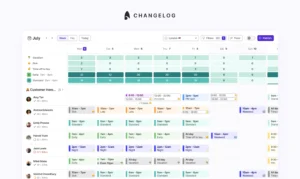
CX Demand Forecasting: Benefits, Use Cases, & Implementation

Meet Savannah, a CX team manager at Dossie, an online wellness company. During peak seasons, she wants to ensure her team can effortlessly manage the influx of customer queries, support requests, and inquiries.
Since Savannah is already aware that SLAs tend to drop during peak seasons, from past performance metrics, she’s been using historical data and rough estimates of perceived demand to meet her staffing needs to ensure this doesn’t happen again. Unfortunately, this system isn’t working. Customers are abandoning calls, leaving empty carts, and stopping mid-check-out.
Savannah knows she needs something more scalable, less manual and smarter. Read this post to understand how Savannah could have met her staffing needs while satisfying her workforce and customers.
What is workforce demand forecasting?
Workforce demand forecasting is the process of determining the future staffing requirements of an organisation by analysing,
- historical data (sales, staffing levels, KPIs, etc.)
- seasonal shifts and their impact on workforce planning
- demand fluctuations during the year and recent days/weeks
- weather conditions
- holidays and non-holiday occasions
- economic conditions of the region/country, and
- business growth
Workforce forecasting helps organisations to understand capacity requirements to meet their business goals. It helps companies avoid overstaffing and understaffing situations during peak & slower periods, preparing business owners for unprecedented market shifts.
What is the goal of workforce demand forecasting?
84% of organisations pointed out labour shortages as a significant challenge for their business. Factors of unpredictable customer demands and interactions and the unavailability of adequate staff to meet their requirements make staffing difficult.
Therefore, the ultimate goal of workforce forecasting is to meet customer demands as they surface by making the right staff available at the right time.
Here are some ways to seamlessly manage seasonal and occasional peaks.
The unprecedented fluctuations in customer queries and support requests make it challenging for managers to accurately predict the staff required during high-demand periods. It leads to understaffing and unhappy customers.
Forecasting demand for employees avoids this situation. It helps predict customer inflow, call volumes, potential interactions, and the number of agents needed throughout a day, week, month, or year. This way, companies can prepare for the busiest days when they need additional staff to support their CX teams.
Reduce employee turnover and increase retention.
Without forecasting workforce demand, companies risk their staff being inundated with high ticket volumes or underutilised during lull periods. Employees lose motivation and productivity, leading to high turnover rates.
Workforce demand analysis can end this cycle by accurately forecasting staffing levels throughout a given period. It ensures employees stay engaged, motivated, productive, and satisfied. It increases retention and saves businesses from the endless loop of hiring and training their workforce.
Reduce SLA Misses
CX teams are bound to service level agreements (SLAs), defining the rules for response times, service quality, and resolution times. Missing SLAs can affect a business’s support quality, putting them at risk for customer churn and poor CSAT scores. Workforce planning can help teams meet SLA requirements and reach more ambitious targets.
What are the benefits of workforce demand forecasting?
Workforce forecasting makes lives easier for both employees and managers. Here’s how it can benefit your business ⬇️
Optimises workforce scheduling to increase productivity.
In today’s economic climate, businesses are all in on productivity increases and doing more with less. Efficient forecasting systems consider historical ticket data and capture special events and internal business activities to improve workforce schedules.
For example, using a smart scheduling system, a US electric and gas facility increased its on-job time by 29% and total jobs worked by 6%. The system could accurately forecast optimal crews for emergency jobs based on the crew member’s location and job preferences.
Streamlines channel switching and management
Workforce forecasting gives insights into customers’ channels to contact the support staff. Whether it is a phone call, chat, email, or social media, detailed forecasts can determine which channel will have the most traffic during a specific period so you can suggest the right staff at the right times. In call centres, customers switch between channels every instant. They may switch to phone calls if live chat fails to resolve their queries. Forecasting per channel helps managers predict the number of questions/requests for every channel while estimating the staffing requirements to meet customers’ demands while hitting their internal SLAs. It enables the team to manage channel switching without customers abandoning the calls.
Helps in workforce demand planning.
Workforce forecasting is at the core of workforce demand planning because it helps businesses plan employee hiring, recruitment, training, and development initiatives. Based on these forecasts, managers can identify existing issues with their workforce and equip themselves with tools to meet future talent demands.
A workforce plan will answer these questions:⬇️
- Will your employees work part-time or full-time?
- Do you need them temporarily or permanently?
- How can you ensure their career growth?
- Do you need to upskill or reskill your existing workforce?
- Can you take on more projects with your current capacity?
- Do you need to optimise your workforce schedules to improve utilisation rates?
Save on unwanted workforce expenses.
Workforce demand forecasting saves your company unnecessary costs like hiring fees, recruitment costs, training and supervision costs, and overtime costs.
Forecasting employee demand ensures you only have the needed talent and are not wasting your time, money, and resources on extra hires. It gives insights into employee availability, adherence, budgeted hours and more. Using this information, you can employ the right people in the right jobs and eliminate or upskill unqualified people, reducing your staffing expenses.
Reduce shrinkage rates
Only 24% of people reported shrinkage of under 20%, while 3% reported 50%+. This shrinkage could be due to many factors like absenteeism, vacations, sick leaves, training, meetings, or breaks. The only way to reduce shrinkage is to identify staffing needs accurately and schedule working hours considering the availability of agents—a task doable by workforce forecasting.
Workforce forecasts study previous time-offs, breaks, leaves, and training to predict future employee absences and equip managers with adequate backup resources to manage the workload. It is possible when managers also have the data on peak and non-peak demand periods to determine the staffing needs for every occasion.
Where else can you implement workforce demand forecasting?
When you forecast labour demand, it is not limited to predicting staffing needs for CX teams. Other departments in the organisation equally benefit from the forecasts.
- Budgeting and resource allocation
New hires, training programs, resource investments, and other workforce expenses need a budget. Forecasting demand for employees helps businesses prepare this budget in advance and allocate the necessary resources.
- Succession planning
Workforce demand forecasting can reveal the reasons behind employee turnover rates and potential gaps in leadership. Using this data, you can create succession plans and train your existing workforce to bridge these gaps. Plus, you can add more people to meet your needs.
How to forecast workforce demand using Surfboard
With integrated forecasting, Surfboard allows CX teams to predict customer inflow and staffing needs up to 12 weeks into the future. Here’s how it works:
- Ticket extraction, filtering, and grouping
Surfboard directly integrates with ticketing systems like Zendesk, Intercom, Front, Salesforce and more to pull historical ticket data and groups. The tool allows users to assign average handle times, ASAs and SLAs per ticket group to ensure accurate forecasting.
- Automated forecasting
Based on ticketing data, surfer availability, shrinkage, historical performance metrics, and your inputs, Surfboard predicts how many inbound tickets your team will receive per channel per hour.
- Add Easy Adjustments
Events like sale campaigns, product updates/launches, and Surfboard allow you to make forecast adjustments to customise the forecast volume for special occasions based on your computation of percentage uplift. It can enhance forecasting capabilities to plan for specific periods when customer demands peak.
Read how Bloom & Wild (a D2C flower delivery company) used Surfboard to plan for peak times and grew by 160% during heavy seasonal requirements.
Optimise workforce demand forecasting with Surfboard
Workforce forecasting isn’t new. It has been helping businesses fulfil their staffing needs for a while now. What changed, though, is the way technology has upgraded forecasting capabilities to improve its accuracy and your workforce’s productivity.
Surfboard demonstrates how smart, accurate, and customisable workforce forecasting is meant to be. The scheduling software features automated forecasting to employ the right people in the right place and time.
Book a demo today so that we can help you transform the way your workforce plan and schedule your team.
FAQs
- How does workforce planning help forecast demand?
Workforce planning maps out the strategy to hire new people, train them, and adjust workforce schedules. When managers have insights into their current workforce, they can identify their needs to meet their business goals. Managers can predict workforce demand once they know the best course of action.
- Why is workforce demand forecasting important?
Workforce demand forecasting is vital to ensure customers always have assistance as and when needed without affecting your staff’s motivation.
- What are the major benefits of workforce demand forecasting?
The major benefits of workforce demand forecasting include⬇️
- Enhanced customer experience
- Reduced workforce expenses
- No more understaffed or overstaffed teams
- High employee productivity and motivation
- Low employee turnover rates
- High-profit margins due to repeat business



